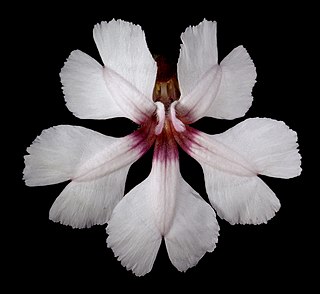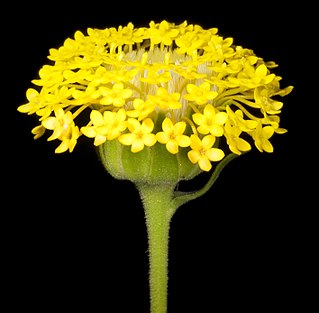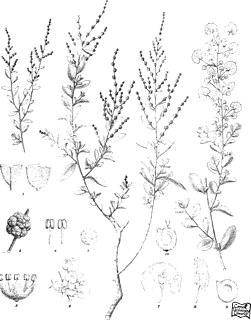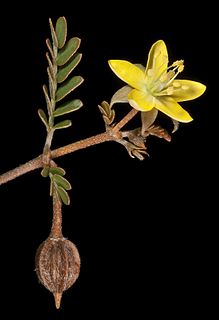
Johnsonia pubescens, commonly called the pipe lily, is a grass-like plant in the family Asphodelaceae, subfamily Hemerocallidoideae, endemic to the south-west of Western Australia. As with others in the genus, it is distinguished by its minute flowers which are on the end of a spike and hidden by large, overlapping, papery bracts.

Velleia lyrata is a small perennial herb in the family Goodeniaceae, endemic to Australia. It is found mainly near Sydney, but also near the NSW and Queensland border, and in Queensland. A map of its occurrence records is given here. It grows in damp situations in heath on sandy soils. The cordate base to the adaxial sepal is a feature distinguishing it from many other Velleias. A full description of the plant is given in Flora of Australia online.

Maireana pyramidata is a species of plant within the genus, Maireana, in the family Amaranthaceae. It is endemic to Australia, and widespread throughout Australia in the inland, where it is found in Victoria, New South Wales, Queensland, the Northern Territory and Western Australia.

Boronia lanuginosa is a plant in the citrus family Rutaceae and is endemic to northern Australia. It is a shrub with woolly pinnate leaves.

Scaevola canescens is a species of plant in the family Goodeniaceae. It is endemic to Western Australia where it occurs "from Shark Bay to Perth, in open forest and heath in sandy soil".

Velleia rosea is a member of the family Goodeniaceae that is native to Western Australia and flowers from April to October.

Velleia connata is an erect annual herb in the family Goodeniaceae, and is found in all mainland states and territories of Australia. It grows on sandplains and stony hills in Beard's eremaean province. Its flowers are yellow-brown or white-pink and it flowers mainly from February or May to October.

Velleia glabrata is an annual herb in the family Goodeniaceae, which is native to all mainland states and territories of Australia with the exception of Victoria. It grows on sand and clay, flowering from June to October.

Bossiaea bossiaeoides is a glaucous shrub from 0.5 to 2 m high, in the pea family (Fabaceae), which is found in northern Australia, in the Northern Territory, Queensland and Western Australia. Apparently leafless, it has branches which are broadly winged. It grows on sand and sandstone, on stony hillsides, creek banks and outcrops. Its flowers are yellow and it flowers from April to August.

Bossiaea rupicola is an erect shrub in the pea family (Fabaceae), which is native to Queensland and New South Wales.

Bossiaea brownii is a member of the genus Bossiaea in the pea family (Fabaceae) which is endemic to Queensland (Australia).

Burchardia congesta is a perennial herb in the family Colchicaceae, and is native to Western Australia.

Calandrinia corrigioloides is an annual herb in the family Montiaceae, and is native to Western Australia, South Australia, and Victoria.

Calandrinia granulifera is an annual herb in the family Montiaceae, and is native to New South Wales, Tasmania, Western Australia, South Australia, and Victoria.

Podotheca chrysantha is a small herb in the family Asteraceae endemic to Western Australia. It grows from 0.2 to 0.5 m high, and has yellow flowers which are seen from August to December. It grows in sand over limestone or laterite on limestone ridges and in wet depressions.

Atriplex stipitata, known as mallee saltbush and kidney saltbush, is a species of shrub in the family Amaranthaceae, found in all mainland states of Australia.

Tribulus macrocarpus is a species of flowering plant in the family Zygophyllaceae, which is found to the central north of Western Australia, and southern inland Northern Territory and northern South Australia.

Caesia micrantha is a species of flowering plant in the family Hemerocallidaceae native to Western Australia.

Gastrolobium villosum is a low spreading shrub in the pea family (Fabaceae), native to Western Australia. Like most Gastrolobiums it is poisonous to stock.

Asteridea pulverulenta is a species of flowering plant in the Asteraceae family, which is endemic to Western Australia, in the south-west. It was first described in 1839 by John Lindley. It is an annual herb, growing on sandy soils to heights of from 5 cm to 70 cm. Its white flowers may seen from October to January on coastal dunes and sandplains.




















